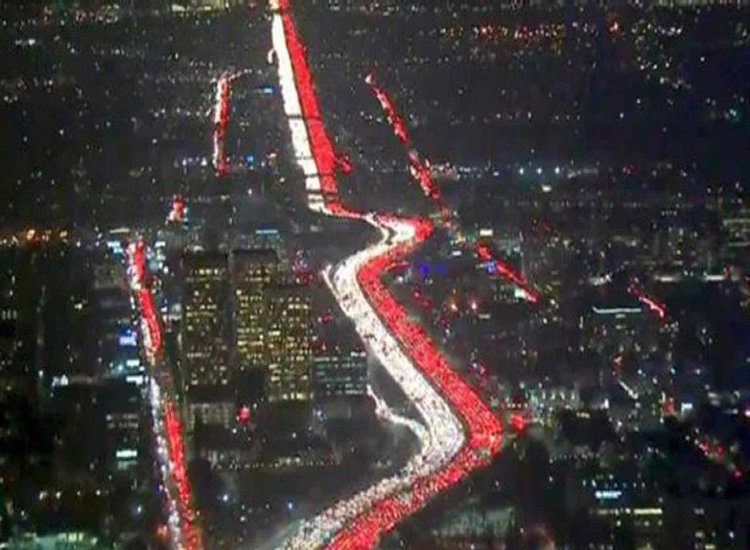


Rental cars can come with GPS devices with this feature as well. Smartphones have good traffic features – the iPhone’s Google Maps traffic feature is fast and reliable, while my clunky old Blackberry takes longer to load updated traffic information. For freeway traffic especially, use a live mapping feature like Google Maps’ traffic feature on your smartphone.Planning alternate traffic routes is a good travel tip in general, but never more so than when driving in congestion-prone areas like Los Angeles. Is going on a freeway absolutely necessary? If you’re just traveling somewhere a couple of neighborhoods away, surface streets are your best bet. Los Angeles is a huge sprawl, yes, but it’s really made up of many distinct neighborhoods.Ignore the Solvang, not sure how that got there. This conversation has been edited for length and clarity.Red means heavy traffic, green, easy-peasy. It’s just not going to be possible for them to live in in Pasadena and drive to Santa Monica and feel like they can do that comfortably. The expectation that someone should be able to get in their car and drive through one of the largest cities in the world unimpeded from one end of the metropolitan area to the other is an expectation that could have existed when L.A.

If you went that far in Tokyo, you’d cover an area that has most of the population for California. KCRW: I have coworkers that live in Pasadena and it takes an hour and a half at minimum each way to get to work in Santa Monica.īT: I think that the idea that we should build a system that allows someone to live 30 miles from where they work is ridiculous. So quality of life is not measured by traffic delays. Well, it may make traffic worse but it doesn’t mean that people are worse off as a result. People say this is just going to make traffic worse. KCRW: We’re at kind of a reckoning, we’re at a juncture.īT: Yeah, and because we haven’t solved those problems.That’s why simultaneously traffic is getting worse and housing is becoming unaffordable, because whenever we try and build in the inner city large amounts of housing there’s tremendous pushback. Over time, Santa Monica ,West Hollywood and many things in-between from downtown to the west side will look more and more like San Francisco and Chicago and New York and Boston and less and less like San Diego. Is it one where we’re going to have affordable housing – then we’re going to have a very urban environment with congested streets where people have lots of options to walk into bike and take transit. Many of the debates you see playing out in places like Santa Monica are really heartfelt arguments about the future. And a lot of the debates we have about affordable housing, about traffic congestion, are really debates about a city in the past which was this bucolic Southern California bungalow environment and an urban global city of the future where you’re likely to have more people living in townhouses and condominiums. This is becoming a more and more urban place. And so you have more people driving a modest amount, but crowded together and still depending largely on the automobile.īT: We are urbanizing. It’s because our densities are are moderately high. has become a global city and it’s continuing to densify it has very heavy traffic congestion, not because people drive a lot people actually drive less in L.A. KCRW asked Bryan Taylor about Robinson’s question and talked to him about how LA can adapt as traffic gets worse.īRIAN TAYLOR: One of the questions that we have is how do we accommodate many people driving around in their own car in large cities? And there’s no easy answer to that. I drive all over Southern California for my job and drive times have increased by 100 percent.” “What is going on with traffic over the last few years. Taylor says LA is transforming into an urban global city of the future, like New York or Tokyo and there’s no going back. They are participating in civic and economic activities.

A recent report by Taylor found that people living in densely developed, congested areas are living more active lives than those in outlying areas. However, congestion doesn’t necessarily mean residents have to suffer. The main driving force, according to UCLA urban planning professor Bryan Taylor, is that LA’s population density is increasing, which means more people and more people are sharing the same amount of space in the city. Traffic in Los Angeles is getting worse and the amount of time people spend in their keeps going up year after year.


 0 kommentar(er)
0 kommentar(er)
